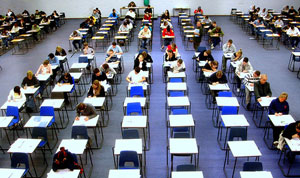Mega-instellingen onder de loep

In de New York Times verscheen de volgende analyse op grond vanhet nieuwe boek How High Schools Become Exemplaryvan Ronald F. Ferguson, Harvard-econoom die onderzoek doet naar’the minority achievement gap.’
Een van de opmerkelijke aspecten dat aan de orde komt in hetverhaal: ‘Teachers were urged to make sure students heard thephrase, “When you go to college …” in every class, every day.When the school began receiving academic awards, they were madeinto banners and displayed prominently. Athletics had traditionallybeen valued above academic success, and coaches had routinelypressured teachers to raise the grades of star players to maintaintheir eligibility. Dr. Szachowicz said she put an end to anyexceptions.’
Het gehele stuk leest u hier:
“A decade ago, Brockton High School was a case study in failure.Teachers and administrators often voiced the unofficial schoolmotto in hallway chitchat: students have a right to fail if theywant. And many of them did – only a quarter of the students passedstatewide exams. One in three dropped out.
Then Susan Szachowicz and a handful of fellow teachers decidedto take action. They persuaded administrators to let them organizea schoolwide campaign that involved reading and writing lessonsinto every class in all subjects, including gym. Their efforts paidoff quickly. In 2001 testing, more students passed the state testsafter failing the year before than at any other school inMassachusetts. The gains continued. This year and last, Brocktonoutperformed 90 percent of Massachusetts high schools. And itsturnaround is getting new attention in a report, “How High SchoolsBecome Exemplary,” published last month by Ronald F. Ferguson.
What makes Brockton High’s story surprising is that, with 4,100students, it is an exception to what has become received wisdom inmany educational circles – that small is almost always better. Thatis why the Bill and Melinda Gates Foundation spent hundreds ofmillions of dollars in the last decade breaking down big schoolsinto small academies (it has since switched strategies, focusingmore on instruction).
The small-is-better orthodoxy remains powerful. A new movie,”Waiting for Superman,” for example, portrays five charter schoolsin New York, Los Angeles and elsewhere – most with only a fewhundred students – as the way forward for American schooling.Brockton, by contrast, is the largest public school inMassachusetts, and one of the largest in the nation.
At education conferences, Dr. Szachowicz – who became Brockton’sprincipal in 2004 – still gets approached by small-school advocateswho tell her they are skeptical that a 4,100-student school couldoffer a decent education. “I tell them we’re a big school thatworks,” said Dr. Szachowicz, whose booming voice makes her seemtaller than 5-foot-6 as she walks the hallways, greeting students,walkie-talkie in hand. She and other teachers took action in partbecause academic catastrophe seemed to be looming, Dr. Szachowiczand several of her colleagues said in interviews here.
Massachusetts had instituted a new high school exit exam in1993, and passing it would be required to graduate a decade later.Unless the school’s culture improved, some 750 seniors would bedenied a diploma each year, starting in 2003. Dr. Szachowicz andPaul Laurino, then the head of the English department – he hassince retired – began meeting on Saturdays with any colleagues theycould pull together to brainstorm strategies for improving theschool.
Shame was an early motivator, especially after the release ofthe 1999 test scores. “They were horrible,” Dr. Szachowiczrecalled. She painted them in bold letters on poster paper in thegroup’s Saturday meeting room. “Is this the best we can be?” shewrote underneath. The group eventually became known as the schoolrestructuring committee, and the administration did not stand inthe way. The principal “just let it happen,” the Harvard reportsays.
The committee’s first big step was to go back to basics, anddeem that reading, writing, speaking and reasoning were the mostimportant skills to teach. They set out to recruit every educatorin the building – not just English, but math, science, evenguidance counselors – to teach those skills to students. Thecommittee put together a rubric to help teachers understand whatgood writing looks like, and began devoting faculty meetings toteaching department heads how to use it. The school’s 300 teacherswere then trained in small groups.
Writing exercises took many forms, but encouraged students tothink methodically. A science teacher, for example, had herstudents write out, step by step, how to make a sandwich, startingwith opening the cupboard to fetch the peanut butter, throughwashing the knife once the sandwich was made. Other writingexercises, of course, were much more sophisticated. Some teachersdragged their feet. Michael Thomas, now the district’s operationsdirector but who led the school’s physical education department atthe time, recalled that several of his teachers told him, “This isgym; we shouldn’t have to teach writing.” Mr. Thomas said hereplied, “If you want to work at Brockton High, it’s your job.”
Fear held some teachers back – fear of wasting time on whatcould be just another faddish reform, fear of a heavier workload -and committee members tried to help them surmount it. “Let me helpyou,” was a response committee members said they often offered toreluctant colleagues who argued that some requests were toodifficult.
The first big boost came with the results of the spring 2001tests. Although Brockton’s scores were still unacceptably low, theyhad risen sharply. The state education commissioner, David P.Driscoll, traveled to Brockton to congratulate the school’scheering students and faculty. “It had become dogma that smallerwas better, but there was no evidence,” said Mr. Driscoll, whosince 2007 has headed the National Assessment Governing Board,which oversees federal testing. “In schools, no matter the size -and Brockton is one of the biggest – what matters is uniting peoplebehind a common purpose, setting high expectations, and stickingwith it.”
After that early triumph, remaining resistance among the facultygave way, Dr. Szachowicz said. Overnight, the restructuringcommittee gained enormous credibility, and scores of once-reluctantteachers wanted to start attending its Saturday meetings, whichcontinue today. Brockton never fired large numbers of teachers, incontrast with current federal policy, which encourages failingschools to consider replacing at least half of all teachers toreinvigorate instruction.
But Dr. Szachowicz and her colleagues did make some teachersuncomfortable, and at least one teacher who refused to participatein the turnaround was eventually dismissed after due processhearings. Teachers unions have resisted turnaround efforts at manyschools. But at Brockton, the union never became a seriousadversary, in part because most committee members were unionizedteachers, and the committee scrupulously honored the unioncontract.
An example: the contract set aside two hours per month forteacher meetings, previously used to discuss mundane schoolbusiness. The committee began dedicating those to teacher training,and made sure they never lasted a minute beyond the time allotted.”Dr. Szachowicz takes the contract seriously, and we’ve workedtogether within its parameters,” said Tim Sullivan, who waspresident of the local teachers union through much of the lastdecade.
The committee changed many rules and policies. The school had anelaborate tracking system, for instance, that channeled studentsinto one of five academic paths. It was largely eliminated becausethe “basic” courses set low expectations for poor-performingstudents. The committee worked to boost the aspirations ofstudents, 69 percent of whom qualify for free lunches because oftheir families’ low incomes. Teachers were urged to make surestudents heard the phrase, “When you go to college …” in everyclass, every day.
When the school began receiving academic awards, they were madeinto banners and displayed prominently. Athletics had traditionallybeen valued above academic success, and coaches had routinelypressured teachers to raise the grades of star players to maintaintheir eligibility. Dr. Szachowicz said she put an end to anyexceptions. But the school retained all varsity sports, as well asits several bands and choruses, extensive drama program and scoresof student clubs.
Many students consider the school’s size – as big as many smallcolleges – and its diverse student body (mostly minority), to bepoints in its favor, rather than problems. “You meet a new personevery day,” said Johanne Alexandre, a senior whose mother isHaitian. “Somebody with a new story, a new culture. I havePakistani friends, Brazilians, Haitians, Asians, Cape Verdeans.There are Africans, Guatemalans.” “There’s a couple of Americans,too!” Tercia Mota, a senior born in Brazil, offered. “But therearen’t cliques. Take a look at the lunch table.” “You can’t say,those are the jocks, those are the preppy cheerleaders, those arethe geeks,” Ms. Mota said. “Everything is blended, everybody’sfriends with everyone.”
Over the years, Brockton has refined its literacy curriculum.Bob Perkins, the math department chairman, used a writing lessonlast week in his Introduction to Algebra II class. He wrote “3 + 72- 6 x 3 – 11” on the board, then asked students to solve theproblem in their workbooks and to explain their reasoning, step bystep, in simple sentences. “I did the exponents first and squaredthe 7,” wrote Sharon Peterson, a junior. “I multiplied 6 x 3. Iadded 3 + 49, and combined 18 and 11, because they were bothnegatives. I ended up with 52-29. The final answer was 23.” Somestudents had more trouble, and the lesson seemed to drag a bit.”This is taking longer than I expected, but it’s not wasted time,”Mr. Perkins said. “They’re learning math, but they’re also learningto write.”
Brockton’s performance is not as stellar in math as in Englishlanguage arts, and the committee has hired an outside consultant tohelp develop strategies for improving math instruction, Mr. Perkinssaid. Dr. Ferguson said Brockton High first “jumped out of thedata” for him early last year. He was examining Massachusetts’ 2008test scores in his office in Cambridge, and noticed that Brocktonhad done a better job than 90 percent of the state’s 350 highschools helping its students to improve their language artsscores.
Since then, he has visited Brockton intermittently and invitedsome of its faculty to the Harvard campus for interviews. Thereport he wrote with four other Harvard researchers includes ananalysis of exemplary performance not only at Brockton, but also at14 other schools in five states. The report noted onecharacteristic shared by all: “Achievement rose when leadershipteams focused thoughtfully and relentlessly on improving thequality of instruction.”
Brockton was by far the largest, but only five of the exemplaryschools had fewer than 1,000 students, while six had more than1,700 and two in Illinois had more than 3,000. “I never bought intothe dogma that a huge school can’t be great,” Dr. Fergusonsaid.
Meest Gelezen
‘Free riding brengt het hoger onderwijs in de problemen’
Vrouwen houden universiteit draaiende, maar krijgen daarvoor geen waardering
Hbo-docent wil wel rolmodel zijn, maar niet eigen moreel kompas opdringen
‘Sluijsmans et al. slaan de plank volledig mis’
Aangepast wetsvoorstel internationalisering dient vooral samenleving in plaats van student



